- Home
- Technology
- Ricoh's Technology
- High-resolution Electrodes Patterning Technology Using Printing Methods
High-resolution Electrodes Patterning Technology Using Printing Methods
Display Technology with Printing
"Printed Electronics" is a technology for building up electronic devices by printing methods, such as ink-jet printing, flexographic printing, screen printing, gravure printing and off-set printing with metal and semiconductor inks. This additive manufacturing process is gaining attention as a low-cost processing technology with low environmental impact thanks to its advantages in material efficiency and low-temperature process compared with conventional semiconductor processes that need etching on thinned functional materials.
Unique technologies like surface energy controlled ink-jet printing (forming hydrophilic and hydrophobic area on the surface of the novel polyimide film on film substrate, and applying ink on hydrophilic area) are superior in resolution to conventional ink-jet printing.
Finer transistor circuits have been fabricated on plastic substrates at low temperature using surface energy controlled ink-jet printing, ink formula, ink-jetting control, and several printing methods.
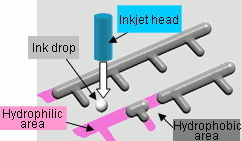
Fig. 1 Description of the Surface Energy controlled Ink-jet printing method
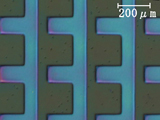
(a) With surface energy control

(b) Without surface energy control
The electrodes printed with Ricoh's unique surface energy controlled ink-jet technology
(a) are much more precise than (b), showing no interference fringe (smooth surface).
Fig. 2 Optical micrograph of Electrodes with (a) and without (b) the surface energy controlled ink-jet printing.
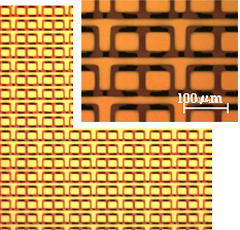
Fig. 3 300ppi TFT array with 1T1C after SD electrodes fabrication
Integration of Printing Process and Laser Processing
We have developed the via formation process, via hole formation by laser ablation to connect two electrodes first, and then via hole filling by ink-jet printing during upper electrode formation.
Using laser ablation for the via hole, only one additional step is needed for our unique all printed TFT fabrication . We are connecting two more TFTs with finer patterning, and can fabricate higher functionality (Fig. 4).
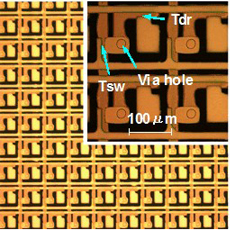
Fig. 4 150 ppi TFT array with 2T1C after SD electrodes fabrication
Demonstration of Flexible Display with Printed circuit
A thin lightweight high-resolution display was achieved in laminating electrophoretic sheets with 200 ppi all-printed OTFT backplanes on a plastic substrate. We achieved the optimal resolution (200ppi=pixels per inch) as a display driven by transistor circuits in which every component (electrodes, semiconductors, insulators and wiring) is fabricated solely with printing.
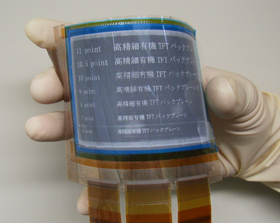
Fig. 5 A high-resolution (200 ppi) display on film substrates
Innovative Technology
We have achieved the optimal resolution (300ppi=pixels per inch, TFT pitch:80µm) as a voltage-driven transistor circuit with one capacitor and one transistor (1T1C), in which all components (electrodes, semiconductors, insulators and wiring) are fabricated by the printing process.
We have also achieved the optimal resolution (150ppi=pixels per inch, TFT pitch:169µm) as a current-driven transistor circuit with one capacitor and two transistors (2T1C), in which all components (electrodes, semiconductors, insulators and wiring) are fabricated by printing and laser processing.
Applications
The low-cost, low-environmental-impact, high-resolution, low-temperature process can be applied to various large-area flexible devices (not restricted to displays); these include sensors and RF-ID tags, all important in the low-carbon society.
This Ricoh-developed technology is expected to contribute to continued progress in printed electronics.
Sorted by : field “Inkjet” “Printed Electronics”
Related Paper
-
An All-printed Organic TFT Backplane for Flexible Electrophoretic Displays
(Source: Ricoh Technology Report No.35)(PDF: 1,549KB) -
Fine Electrodes Patterning Technologies using Ink-jet Printing and Laser Processing
(Source: Ricoh Technology Report No.40)(PDF: 683KB) -
Fabrication of Organic TFT Array using Ink-jet Printing and Laser Processing
(Source:Proc. International Conference on Flexible and Printed Electronics (ICFPE) 2012, S5-I2 (2012))(PDF:146KB) -
High-resolution Patterning Technologies using Ink-jet Printing and Laser Processing for Organic TFT Array
(Source:Society for Imaging Science and Technology, Proc. of NIP 29 and Digital Fabrication 2013)(PDF:1,138KB) -
All-printed Organic TFT Backplanes for Flexible Electronic Paper
(Source:The Imaging Society of Japan, Proc. of Int'l Symposium on Electronic Paper 2010) (PDF: 1,253KB) -
A 200 ppi All-printed Organic TFT Backplane for Flexible Electro-phoretic Displays
(Source:ITE/SID, Proc. of IDW2009, The 16th Int'l Display Workshop)(PDF: 571KB) -
A 160ppi All-printed Organic TFT Backplane for Flexible Electro-phoretic Displays
(Source:ITE/SID, Proc. of IDW2008, The 15th Int'l Display Workshop)(PDF: 495KB)
*This paper won a "Best Paper Award" of IDW'08.
